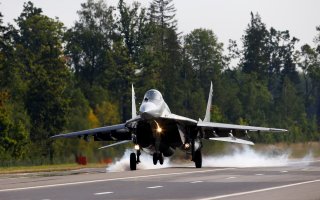Meet the MiG-29: Russia's Very Own 'F-16' (Watch the Video)
The MiG-29 has been gradually recast as a multi-role aircraft with an increasingly robust air-to-surface armament suite.
Here's What You Need to Know: For a major military power like the Soviet Union and its Russian successor, there is always going to be a glut of aircraft roles to fill at various intensity levels and operational uses.
As with many of Russia’s most prolific aircraft, the MiG-29 has spawned numerous variants four decades of service. Originally intended as an superiority fighter, and particularly as the Soviet answer to the F-16, the MiG-29 has been gradually recast as a multi-role aircraft with an increasingly robust air-to-surface armament suite.
The MiG-29’s new purpose was on full display at a recent combat exercise at the Ashuluk training grounds near the Astrakhan region in southwestern Russia. In a rarity for publicized, high-profile Russian aircraft drills, a squad of upgraded MiG-29SMT’s was deployed for the explicit purpose of neutralizing “international terrorists.” Specifically, they were practicing coordinated airstrikes against light armor columns.
TV Zvezda, the official television channel of Russia’s Defense Ministry, released a clip of the exercise (see the previous link).
The footage depicts MiG-29SMT’s flying in formation, before panning to a brief shot of the SMT’s partly digitized avionics. A fighter can be seen discharging its armaments; the moment of impact was not shown, but Zvezda reports that the SMT’s fired unguided S-13 rockets at a light armor column with good effect on target (GEOT). The MiG-29SMT’s proceeded to practice dogfighting maneuvers in pairs before returning to base.
Unsurprisingly, the SMT upgrade package revolves around a much-improved ground attack capability. It gives the MiG-29 access to an expanded suite of Kh-29, Kh-31, and Kh-25 air-to-surface and anti-ship missiles, with six external hardpoints to deploy them. As with almost all Soviet-era aircraft, it is compatible with the aforementioned, highly versatile S-13 line of unguided rockets. Aside from typical modernization improvements in updated avionics and increased ECM (electronic countermeasures) tools, the SMT introduces a new antenna array better suited for detecting ground targets.
The SMT is still considered a first-generation MiG-29 variant, but nonetheless features many of the improvements introduced by the second-generation MiG-29M. It is the MiG-29M that first modernized the basic MiG-29 formula, introducing a new lightweight frame to increase maneuverability, and-- in addressing one of the foremost criticisms of its predecessor-- a drastically increased combat range of 2,000 kilometers (km), as opposed to the 1,500 km of the original MiG-29. The MiG-29M’s upgrade path is fully realized with the upcoming MiG-35, a deeply modernized multi-role fighter that advances the MiG-29M formula with fifth-generation avionics and a proprietary Zhuk-AE active electronically scanned array (AESA) radar.
Understandably, there is a temptation to view these many MiG-29 variants on a spectrum of linear progression; of one model replacing the next in a constant cycle of technological improvement. But, as previously discussed by The National Interest, this is a total misconception of Russia’s military aircraft development strategy. The MiG-29M will not become obsolete with the imminent release of the MiG-35, just as first-generation MiG-29 models were not rendered obsolete by the MiG-29M.
For a major military power like the Soviet Union and its Russian successor, there is always going to be a glut of aircraft roles to fill at various intensity levels and operational uses. As a fighter made for pitched, high-intensity warfare in hostile airspace becomes outdated vis-à-vis competing fighters and air defenses, it is no longer able to perform its original role. But, from patrol to support to low-intensity combat missions, there are still many roles for it to perform. At that point, it can simply be retrofitted and redeployed as needed. Of course, It can also be sold; older Soviet aircraft account for a major chunk of Russia’s arms export contracts with Asian and Middle-Eastern purchasers, who tend to prioritize raw performance value over the latest technological bells and whistles.
This, in a nutshell, is the four-decade developmental story of the MiG-29, and the major driving force behind the prevalence of numerous aircraft variants in the Russian Air Force roster.
Mark Episkopos is a frequent contributor to The National Interest. Mark is also a PhD student in History at American University.
This article first appeared in April 2019.
Image: Reuters

